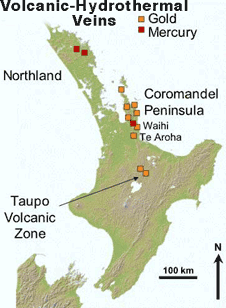 Location of gold and mercury deposits associated with epithermal systems
Location of gold and mercury deposits associated with epithermal systems
These deposits were formed when hot molten rock associated with volcanoes provided a heat source to drive near-surface groundwater into kilometre scale convection systems in the Earth's crust. Geothermal systems such as those exploited at Wairakei and Broadlands are the surface expressions of these systems. Characteristics of the deposits are listed below.
- Deposits are commonly associated with quartz veins which are locally continuous for 100's of metres.
- These deposits are accompanied by large amounts (over 100's of metres or even km) of rock that have been altered to clays by hot water.
- Deposits occur in the North Island, mainly in the Coromandel Peninsula and Taupo Volcanic Zone (see map above).
- The Martha Mine at Waihi is an actively mined example of this deposit type, and the nearby Golden Cross mine is in the latter stages of site rehabilitation.
- Gold is accompanied by arsenic, cadmium, copper, lead, zinc, and some antimony.
- Cadmium, copper, lead and zinc are commonly mobile in surface and ground waters, accompanied by lesser amounts of arsenic and/or antimony.
- Similar deposits, with mercury but little gold, form where hot springs have reached the surface in the past (e.g., Puhipuhi, Northland). Some of these have been mined historically for mercury.
These mercury-rich deposits release arsenic and minor mercury into the environment.
Mine tailings, Te Aroha
- A volcanic-related mineral deposit occurs above the town of Te Aroha.
- The underground Tui Mine extracted copper, lead and zinc sulphides in the 1960's, and the mine tailings were deposited nearby.
- Water discharging from the mine and tailings area has high trace metal contents, especially zinc.
- Waters near the town of Te Aroha have trace metal concentrations near to drinking water limits, because of downstream dilution under normal rainfall conditions.
- The town's water supply was partly obtained from these waters.
- Metal contents became unacceptably high at times of low rainfall, and a different water supply source was necessary.
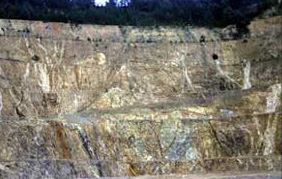 Martha gold mine, Waihi. Gold is found near the white quartz veins. Rocks between the quartz veins have been affected by hydrothermal waters, and many have pyrite. During mining, the pyrite-bearing waste rock is specially handled and stored so that acid waters will not develop.
Martha gold mine, Waihi. Gold is found near the white quartz veins. Rocks between the quartz veins have been affected by hydrothermal waters, and many have pyrite. During mining, the pyrite-bearing waste rock is specially handled and stored so that acid waters will not develop.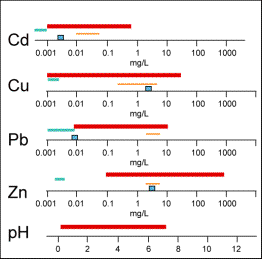 Epithermal mine water compositions (red bars) compared to drinking water limits (blue boxes).
Epithermal mine water compositions (red bars) compared to drinking water limits (blue boxes).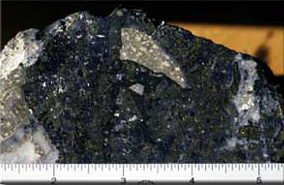
Typical Tui Mine ore
Rich in pyrite, sphalerite (ZnS), galena (PbS) and chalcopyrite (CuFeS2)
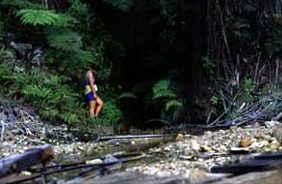
Entrance to underground Tui Mine.
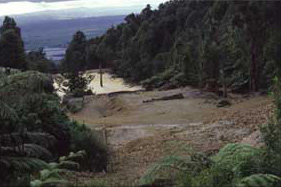
Tui Mine tailings
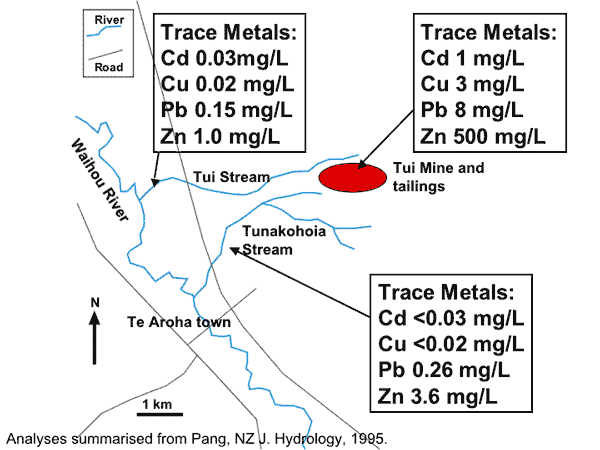 Sketch map showing the Tui Mine site and stream metal contents.
Sketch map showing the Tui Mine site and stream metal contents.Related
Introduction
Overview: Geological setting for Metals in the New Zealand environment
- Epithermal Gold
- Mesothermal Gold
- Acid Rock drainage
- Coal
- Metals in groundwater
- Alluvial Gold
- Northland Mercury
- Hot Springs (in heavy metals)